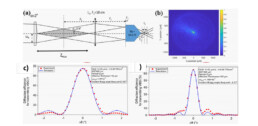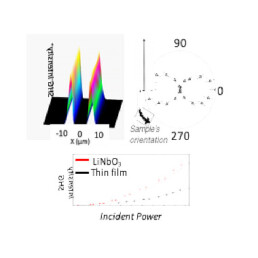Optics Express 129: 69
Demonstration of Type A volume Bragg gratings inscribed with a femtosecond Gaussian-Bessel laser beam.
J. Harb • L. Talbot • Y. Petit • M. Bernier • L. Canioni
To our knowledge, we report on the first demonstration of Type A VBGs inscribed in silver-containing phosphate glasses by femtosecond laser writing. The gratings are inscribed plane-by-plane by scanning the voxel of a 1030 nm Gaussian-Bessel inscription beam. This results in a refractive-index modification zone, induced by the appearance of silver clusters, extending over a much larger depth than those obtained with standard Gaussian beams. As a result, a high diffraction efficiency of 95% at 632.8 nm is demonstrated for a 2-µm period transmission grating with a 150-µm effective thickness indicating a strong refractive-index modulation of 1.78 × 10−3. Meanwhile, a refractive-index modulation of 1.37 × 10−3 was observed at a wavelength of 1.55 µm. Thus, this work opens the avenue for highly effective femtosecond-written VBGs suitable for industrial applications.
Figure : (a) Schematic drawing of the experimental setup for the generation of the Gaussian-Bessel beam using an axicon and the demagnifying 4F optical system. (b) Experimental image profile of the intensity cross-section of the Gaussian-Bessel beam close to the 𝑍𝑚𝑎𝑥2 region. (c-d) Experimental and simulated dependence of the diffraction efficiency on the deviation from the Bragg angle of the transmitting Bragg grating for λ=632.8 nm: (c) incident Bragg angle = 21.62° (first order), (d) incident Bragg angle = -6.17° (second order).
Applied Physics B 129: 69 (2023)
Fabrication and characterization of tapered photonic crystal fiber for broadband 2 µm: four-wave mixing-based fibered OPCPA.
S.E. Ahmedou • G. Walter • J. Herbuvaux • R. Dauliat • S. Février • S. Petit • C. Valentin • D. Marion • J. Lhermite • L. Labonté • S. Tanzilli • F. Gérôme • B. Debord • F. Benabid • B. Leconte • G. Millot • P. Roy • R. Jamier • J.C. Delagnes
In this manuscript, the simulation, fabrication, and characterization of large area microstructured fiber tapers are presented to highlight broadband phase matching conditions of the four wave-mixing process. These silica-based tapers are intended to serve as a nonlinear gain medium for intense and high average power Fiber Optical Parametric Chirped Pulse Amplifier emitting at 2 μm and strongly pumped at Yb wavelength. Different geometries (tapered/untapered, aspect ratio, etc.) are fabricated, analyzed and their broadening properties—key for supporting ultrashort pulses amplification—are compared and discussed. The characterization of nonlinear gain bandwidth of the tapers relies on a tunable source of stochastic pulses based on tunable amplified spontaneous emission in Yb-doped amplifiers. The strong overshoots of this source allow degenerate four-wave mixing process to occur thus generating broadband incoherent visible signal and mid-infrared idler waves at much lower average power than usually needed with coherent pumping. The idler centered around 1.85 μm is broadened due to zero-dispersion wavelength shift along the taper.
Advanced Optical Materials 2000202 (2020)
Electrically micro-polarized amorphous sodo-niobate film competing with crystalline lithium niobate second order optical response.
Lara Karam • Frédéric Adamietz • Dominique Michau • Claudia Gonçalves • Myungkoo Kang • Rashi Sharma • G. Senthil Murugan • Thierry Cardinal • Evelyn Fargin • Vincent Rodriguez • Kathleen A. Richardson • Marc Dussauze
A second order nonlinear optical susceptibility is induced by a thermo-electrical imprinting treatment in an amorphous thin film. A magnitude for the χ(2) of 29 pm/V is measured, this value is the highest ever reported for an amorphous inorganic material. The induced uniaxial non centro symmetry can be localized at the micrometer scale opening the way for new active planar photonic architectures based on amorphous materials.
Figure : Localization, geometry, and magnitude of the induced SONL optical response. a) SHG intensity map realized on the poled film with a linearly polarized light (VV) perpendicular to the imprinted line. b) Normalized SHG intensity as a function of the orientation of the sample (0–180° corresponds to the imprinted line perpendicular to the incident light polarization and 90–270° parallel). c) SHG intensity as a function of the linearly polarized incident light power for the thin film (in black oriented so that the imprinted line is perpendicular to the incident light) and for the LN single crystal (in red–oriented so that the c axis is collinear to the incident light polarization and so that χ(2zzz is probed).


